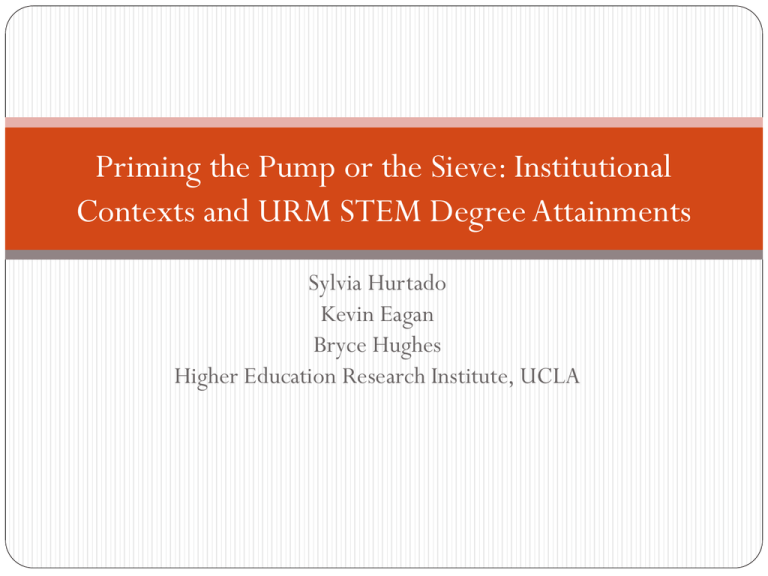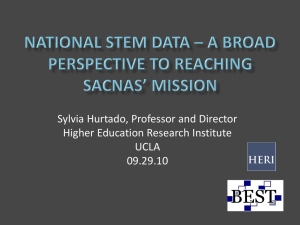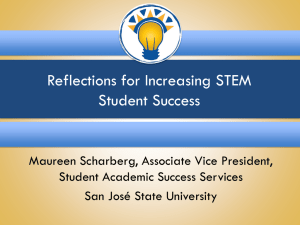Priming the Pump or the Sieve - Higher Education Research Institute
advertisement

Priming the Pump or the Sieve: Institutional Contexts and URM STEM Degree Attainments Sylvia Hurtado Kevin Eagan Bryce Hughes Higher Education Research Institute, UCLA A National Imperative National Academies (2011) report Expanding Underrepresented Minority Participation: America’s Science and Technology Talent Establishes most of the growth in the new jobs will require science and technology skills “Those groups that are most underrepresented in S&E are also the fastest growing the general population” (National Academies, 2011, p. 3). In an effort to achieve long-term parity in a diverse workforce, they recommend a near term, reasonable goal of improving institutional efforts to double the number of underrepresented minorities receiving undergraduate STEM degrees. A National Imperative 2012 President’s Council of Advisors on Science and Technology (PCAST) report, Engage to Excel: Producing One Million Additional College Graduates With Degrees In Science,Technology, Engineering, And Mathematics Increasing the retention of STEM majors from 40% to 50% would, alone, generate three-quarters of the targeted 1 million additional STEM degrees over the next decade. Retaining more students in STEM majors is the lowest-cost, fastest policy option to providing the STEM professionals that the nation needs. Changing productivity levels means changing practices, and mindsets from priming the sieve to priming the pump, or talent development. Purpose of the Study • Identify the faculty and institutional characteristics that contribute to higher rates of STEM degree completion, particularly among underrepresented groups, controlling for students’ entering characteristics. • Identify challenges and opportunities to prime the pump and improve the use of “evidence-based” approaches. Literature Review: Student-level Characteristics Pre-college experiences Strong high school curriculum High test scores and grades Advanced courses in science and mathematics High aspirations for a STEM degree URM students less likely to access AP courses, yet equally or more likely to aspire to a STEM degree Literature Review: Institutional-Level Characteristics Faculty pedagogies STEM courses tend to utilize teacher-centered pedagogies Introductory STEM courses perceived as “gatekeepers” to STEM degrees Student-centered pedagogies key to retaining women and URM students in STEM programs Minority-targeted STEM retention programs Generally improve probability of URM STEM degree completion Mixed results regarding improving URM academic performance Undergraduate research experiences Found to be one of the most effective contributors to increasing URM STEM completion odds Benefits to students participating in undergraduate research may be conditional depending on timing and duration Minority-serving institutions (MSIs) HBCUs in particular provide a unique atmosphere that supports Black students’ degree attainment Research is beginning to demonstrate benefits for other URM students attending other categories of MSIs Literature Review: Are Selective Institutions Better for URM Students? More selective universities have higher graduation rates URM students also graduate at higher rates from more selective institutions More recent studies have found conditions that indicate this benefit does not apply across the board Wider usage of multilevel modeling in higher education research has shown single-level modeling overstates the effects of selectivity Selectivity was found to be negatively related to four-year retention of women of color in STEM Biomedical and behavioral science students attending more selective institutions were slightly but significantly less likely to be retained in these programs to their fourth year Yet many recent multilevel studies continue to confirm selectivity positively predicts higher probability of graduation Percentage of 2004 STEM Aspirants Who Completed STEM Degrees in Four, Five, and Six Years, by Race/Ethnicity 60 52.4 50 46.6 40 35.8 22 43 29 24 24.9 24.3 20 18.2 12.3 0 38.5 29.6 30 10 40.4 9.4 20.2 21.8 11.6 4-Year Completion 5-Year Completion 6-Year Completion All students (N=56,499) White (N=39,160) Asian American (N=7,621) Latino (N=3,863) Black (N=4,695) Native American (N=1,160) Data Source: 2004 Freshman Survey, 2010-11 National Student Clearinghouse; HERI, UCLA Method • Longitudinal Data on STEM Aspirants • Individual level: 2004 Freshman Survey, CIRP merged with completion data from the National Student Clearinghouse • Sample: 58, 292 students across 353 institutions • Faculty Data: 2007 & 2010 HERI Faculty Survey from 659 institutions, with STEM Supplement for over 10,000 STEM faculty • STEM Best Practices Survey – administered to STEM deans and department chairs at our participating campuses • Institutional Data obtained from IPEDS, Aggregates of Faculty, and Aggregates of Peer characteristics from students entering the same institutions in 2004. Method Dependent Variable: STEM completion compared to: Bachelor’s completion in non-STEM field No bachelor’s degree completion-includes students still enrolled (major not known) Measured at four, five, and six years to reflect differences in time to degree Method Independent variables Background characteristics Pre-college preparation and experiences Aspirations and expectations Intended major Aggregate peer effects Institutional characteristics Faculty contextual measures Best practices in STEM Method Analysis National weights Missing data with multiple imputation Multinomial HGLM Limitations Intended rather than declared major NSC data – no information on term-to-term major No college experience measures Few high school preparation variables BPS data reported by STEM Deans and Dept. Chairs Key Findings for Four Year Completers: STEM vs. Non-STEM Denser concentrations of MD aspirants and larger campuses negatively predict STEM completion Differences by race Latino (-), Black(ns) Asian/Pacific Islander (+) Other race (+) Women (-) HS grade (+), and effect enhanced by faculty use of student- centered pedagogy SAT, years of HS math and biology (+) Key Findings for Four-Year Completers: STEM vs. Non-STEM MD aspirant (+) but effect mitigated by faculty grading on a curve and selectivity (-) condition Ph.D./Ed.D. aspirant (+) Law degree aspirant (-) Engineering, physical sciences, health tech/nursing, and computer science (+) Pre-med, pre-pharm, pre-dental, pre-vet (-) Key Findings for Five-Year Completers: STEM vs. Non-STEM Drop in predictive power of institutional size Non-sig difference between Latino/other groups and White students Decrease in gender gap Decrease in salience of SAT Decrease in gap between BA/BS aspirants and law/medical aspirants Changes regarding majors Engineering increased gap, more likely to complete in 5 years Physical science, health tech/nursing, and computer science gap decreased compared to biomedical aspirants Key Findings for Six-Year Completers: STEM vs. Non-STEM Decreased salience of institutional size Closing of gender gap Women at selective institutions have lower STEM completion rates than women at less selective institutions Drop in gap between medical degree aspirants and BA/BS aspirants Key Findings for Four-Year STEM Completion versus No Completion Control: private (+) Research-focused (-) vs. comp. masters Concentration of STEM undergraduates (-) Institutional size (+) Pct. of faculty involving undergraduates in research (+) Selectivity (+) Racial differences: Native American and Latino (-); Asian American (+) Black (-), mitigated by HBCU (+) and selectivity (-) Women (+) Low/Low-middle income (-); upper-middle (+) Key Findings for Four-Year STEM Completion versus No Completion HS GPA, SAT scores, years of math and bio (+) Expect to transfer (-) MD aspirant (+), mitigated by faculty grading on a curve (-) and selectivity (+) Masters degree aspirant (+) Law degree aspirant (-) Engineering and pre-med/pharm/dental/vet (-) Health tech/nursing (+) Key Findings for Five-Year STEM Completion vs. No Completion Loss of significance: institutional control, concentration of STEM undergraduates, size, percentage of faculty involving UGs in research Expanded gender gap (women +) Expanded gap between low-income and middle income Reduced salience for SAT composite MD aspirations become less salient Increased predictive power of planning to live on campus Only academic major difference: premed/pharm/dental/vet (-) compared to biosciences Key Findings for Six-Year STEM Completion vs. No Completion Size and faculty’s involvement of undergraduates in research significant (like in 4-year model) Racial gaps persist, African American and Native Am (- incr.) Gender gap declines and is moderated by selectivity (+) condition Predictive power of MD aspiration drops further, as does law degree aspiration URM Six Year Completers in STEM Compared With Non-STEM Completers: Concentration of premedical undergraduates (-) MD aspirants (+), but MD aspirants at more selective institutions less likely to stay in science than MD aspiring peers at less selective institutions Law degree asp. (-) vs. BA/BS aspirants Engineering aspirants (+) vs. biological sciences, HS GPA (+), and higher achieving students complete at even higher rates on campuses where STEM faculty used student-centered pedagogy more often SAT Composite and years of HS math (+) Females (-) Academic self-concept (+) No significant differences between URM groups among completers in STEM vs. Non-STEM URM Six Year Completers in STEM Compared with non-Completers STEM faculty that involve undergrads in research (+) Selectivity (+) HS STEM outreach programs at institutions (-) Native Americans (-) vs. Latina/os Women (+) English Native speakers (-) Health technology/nursing majors (-) vs. life sciences majors HSGPA, years of HS math, and academic self-concept (+) Intend to live on campus freshman year (+) Conclusion Contexts Matter Selective institutions can improve productivity. They promote degree completion, but students are not more likely to complete in a STEM degrees. Premed Phenomenon Students who begin premed at institutions are more likely to complete in STEM, are less likely to complete in STEM at selective institutions, high % of premeds causes students to switch from STEM among four year completers—presumably a talented group. Conclusion Supportive Environments Work! Minority engineers are more likely to be retained in STEM if they complete college compared to bioscience aspirants. Having an undergraduate research program has an effect on retaining minority students in STEM (and quicker degree completion). Faculty student centered pedagogy was important to staying in STEM for high-achieving minority students. Grading on curve particularly hurt premed aspirants, they were more likely to leave STEM at institutions where used. Conclusion In order to produce 1 million more STEM degrees, we have to address diversity and equity in attainments and improve access to STEM careers. Call for evidence-based teaching practices in STEM. New initiatives by AAU and APLU indicate great interest in “demonstration campuses” that can make transformations to increase productivity of STEM degrees. Contact Information Faculty/Co-PIs: Sylvia Hurtado Mitchell Chang Postdoctoral Scholars: Kevin Eagan Josephine Gasiewski Administrative Staff: Dominique Harrison Graduate Research Assistants: Tanya Figueroa Gina Garcia Juan Garibay Felisha Herrera Bryce Hughes Cindy Mosqueda Papers and reports are available for download from project website: http://heri.ucla.edu/nih Project e-mail: herinih@ucla.edu This study was made possible by the support of the National Institute of General Medical Sciences, NIH Grant Numbers 1 R01 GMO71968-01 and R01 GMO71968-05, the National Science Foundation, NSF Grant Number 0757076, and the American Recovery and Reinvestment Act of 2009 through the National Institute of General Medical Sciences, NIH Grant 1RC1GM090776-01. This independent research and the views expressed here do not indicate endorsement by the sponsors.








